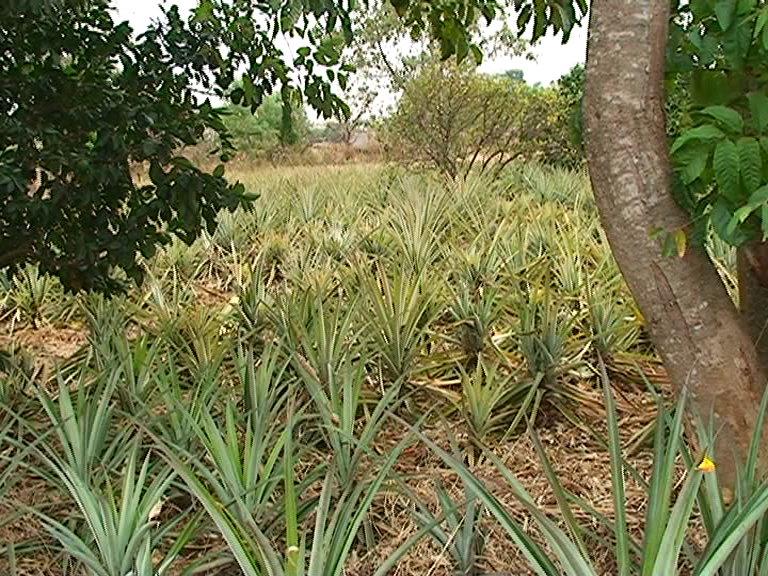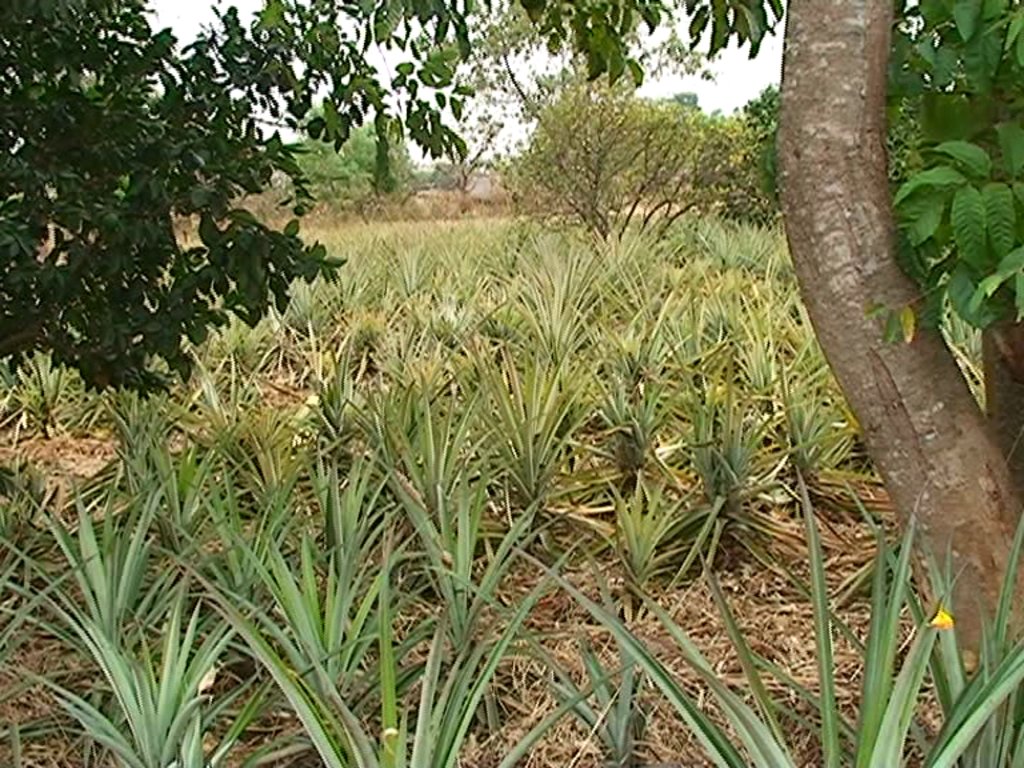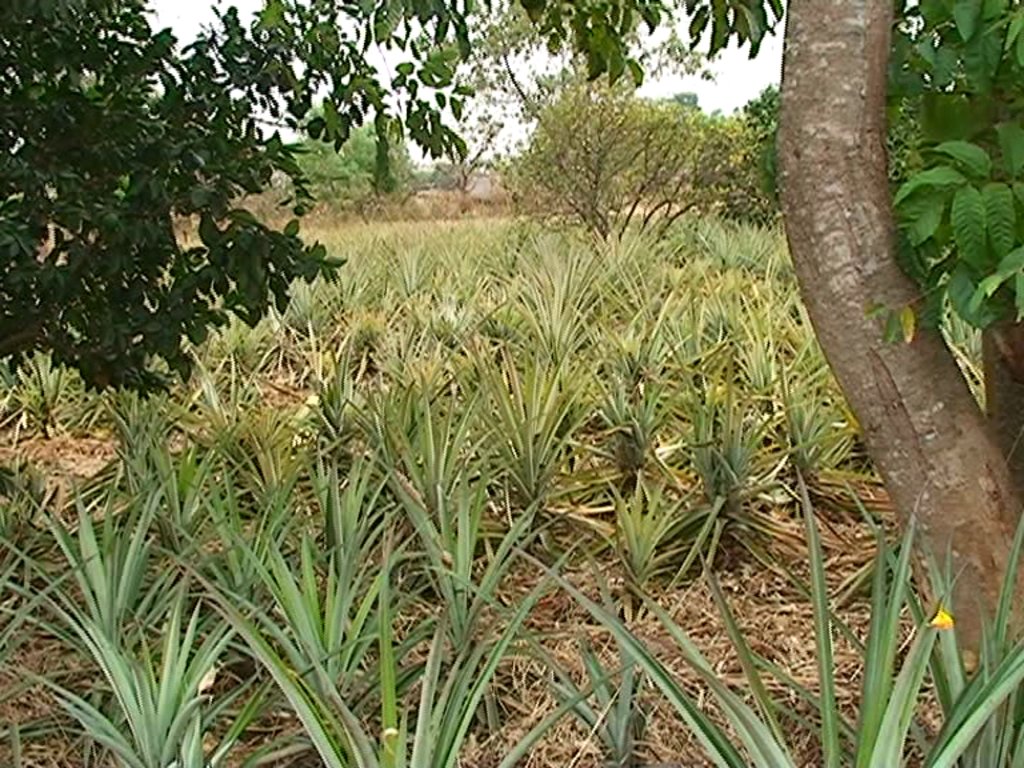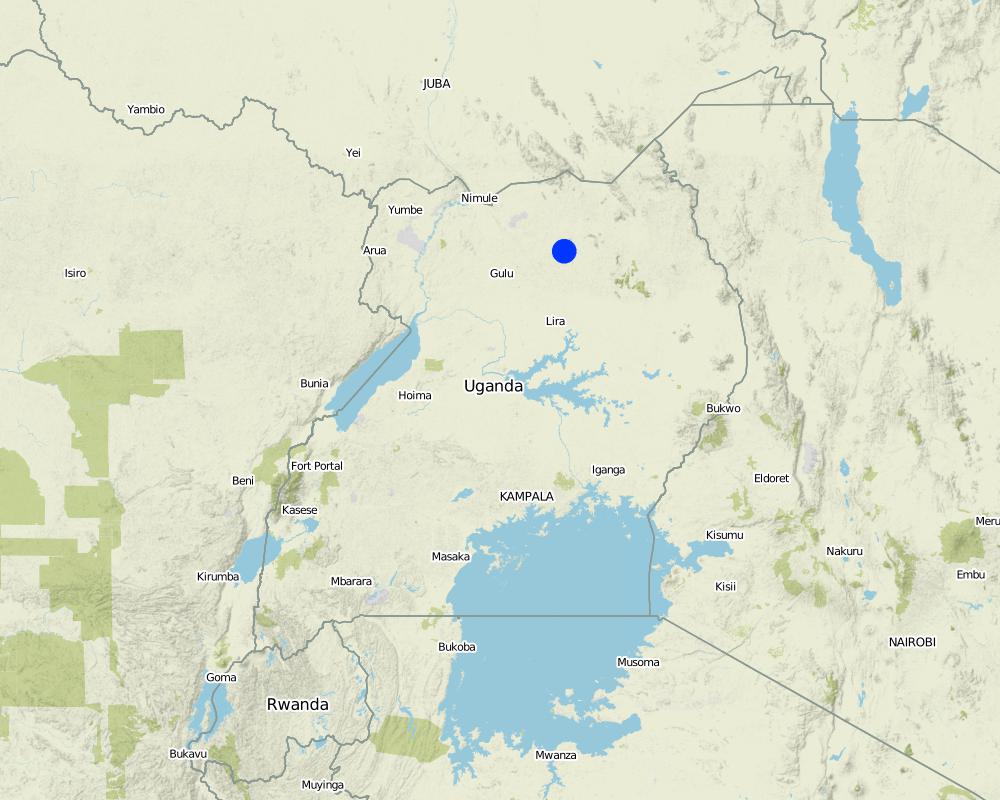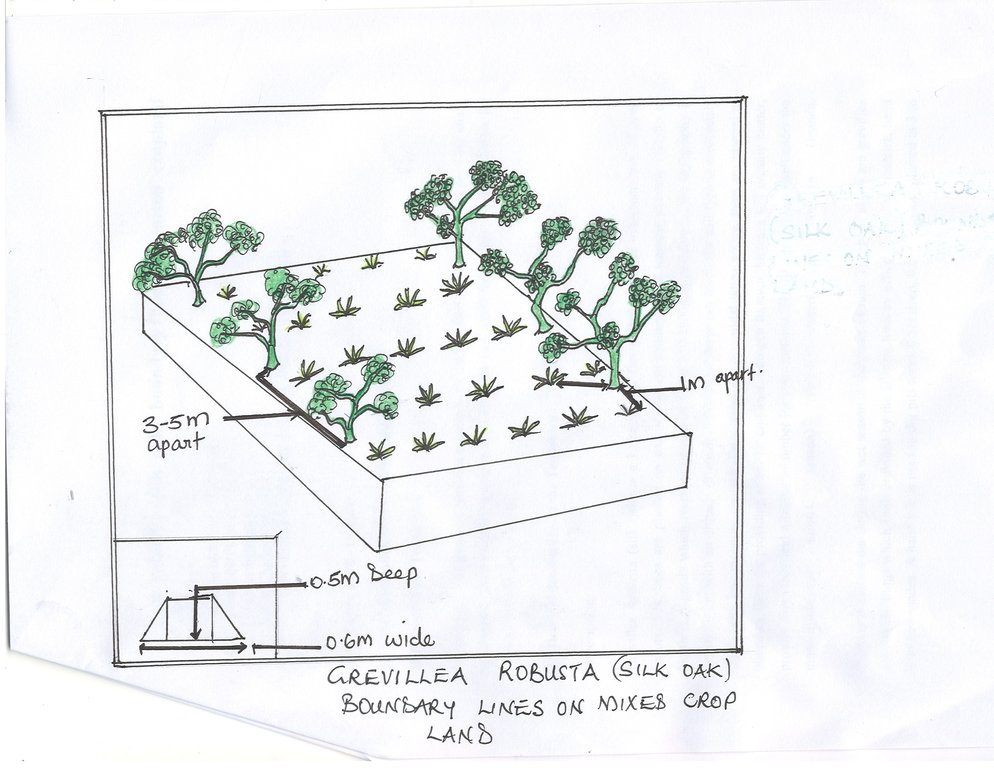Grevillea Robusta (Silk Oak) Boundary Lines on a Pineapple Cropland [Uganda]
- Creation:
- Update:
- Compiler: betty adoch
- Editors: Kamugisha Rick Nelson, Bernard Fungo
- Reviewers: John Stephen Tenywa, Nicole Harari, Renate Fleiner
Yen ipoto
technologies_2778 - Uganda
View sections
Expand all Collapse all1. General information
1.2 Contact details of resource persons and institutions involved in the assessment and documentation of the Technology
Key resource person(s)
land user:
George Kilama
Pader District
Pader District, Laguti Sub county, Paibwor parish, Ojota Village.
Uganda
Name of project which facilitated the documentation/ evaluation of the Technology (if relevant)
Scaling-up SLM practices by smallholder farmers (IFAD)Name of the institution(s) which facilitated the documentation/ evaluation of the Technology (if relevant)
Uganda Landcare Network (ULN) - Uganda1.3 Conditions regarding the use of data documented through WOCAT
When were the data compiled (in the field)?
09/05/2017
The compiler and key resource person(s) accept the conditions regarding the use of data documented through WOCAT:
Ja
1.4 Declaration on sustainability of the described Technology
Is the Technology described here problematic with regard to land degradation, so that it cannot be declared a sustainable land management technology?
Nee
Comments:
The fast-growing Grevillea robusta (silk oak) provides several on-site advantages including acting as windbreak and increasing soil organic matter.
2. Description of the SLM Technology
2.1 Short description of the Technology
Definition of the Technology:
Leguminous, fast growing grevillea robusta (silk oak) planted as boundary lines provides shade to a pineapple cropland, increases soil organic matter, provides fuel wood for domestic use and timber for construction after 5-8 years.
2.2 Detailed description of the Technology
Description:
Grevillea Robusta (silk oak) is a leguminous, fast growing and evergreen tree planted in a natural environment with tropical savanna climate of Northern Uganda which receives rainfall of about 750-1000 mm per annum, established on a generally flat slope with an altitude of about 1000 meters above sea level. The soil type is moderately fertile with low moisture content that favours tree growth. These trees are planted as boundary lines for providing shade on a pineapple cropland, nitrogen fixation, increasing soil organic matter, providing fuel wood and as a source of timber for construction after 5-8 years. The tree species generally grows well under the mono-modal (one rainfall season) rainfall pattern of Northern Uganda.
Planting is normally done during the wet season at the onset of rain in early April and the inputs required for establishing this technology include Grevillea Robusta seedlings majorly provided by the District forestry officers, farmyard manure, hand hoes and spades. A hand hoe is used to dig pits about 0.5 m deep, 0.6 m wide and 3 to 5 m apart and 1 meter away from the pineapple crop. Farmyard manure is added to the pit to fill a depth of about 0.3 m, a layer of top soil is added to 0.2 m depth and the seedling is planted on top. The rest of the pit is filled with soil and watered to improve soil moisture content. Bamboo canes can be woven around the seedlings to protect them from destruction by livestock. Grevillea Robusta grows fast when the boundary line is well established within two years. The pruned branches provide fuel wood for domestic use like cooking and within 5 to 8 years the trees are harvested for timber. Establishment costs for this technology are normally higher compared to maintenance costs especially for the purchase of Grevillea seedlings, manures, farm equipment like hand hoes and pangas. The technology is easily and spontaneously adopted by average smallholder farmers with less than 2 acres and is useful for providing shade to the pineapple crop thus increasing the yield. What is not liked about this technology is that it forms a big canopy that limits photosynthesis. To maintain this technology, the land user has to constantly prune whenever the canopy grows big.
2.3 Photos of the Technology
2.4 Videos of the Technology
Comments, short description:
Grevillea trees along the pineapple field that are flourishing well.
Date:
9/52017
Location:
Pader District
Name of videographer:
Betty Adoch
2.5 Country/ region/ locations where the Technology has been applied and which are covered by this assessment
Country:
Uganda
Region/ State/ Province:
Northern Uganda.
Further specification of location:
Pader Town Council
Comments:
The map shows the land user's Grevillea Robuster garden which is used as wind break and provides shade to the pineapple garden.
Map
×2.6 Date of implementation
Indicate year of implementation:
2012
If precise year is not known, indicate approximate date:
- less than 10 years ago (recently)
2.7 Introduction of the Technology
Specify how the Technology was introduced:
- through land users' innovation
3. Classification of the SLM Technology
3.1 Main purpose(s) of the Technology
- improve production
- preserve/ improve biodiversity
- adapt to climate change/ extremes and its impacts
- create beneficial economic impact
3.2 Current land use type(s) where the Technology is applied

Mixed (crops/ grazing/ trees), incl. agroforestry
- Agroforestry
Main products/ services:
Grevillea trees act as windbreak, provide shade and increase soil organic matter for pineapple crops.
Comments:
Fast growing woody leguminous trees provide shade, shelter from winds, soil fertility maintenance and timber production after 5-8 years.
If land use has changed due to the implementation of the Technology, indicate land use before implementation of the Technology:
The land was used for growing vegetables.
3.3 Further information about land use
Water supply for the land on which the Technology is applied:
- rainfed
Comments:
The grevillea trees rely on rain for growth.
Number of growing seasons per year:
- 1
Specify:
The grevillea tree is a perennial crop
3.4 SLM group to which the Technology belongs
- agroforestry
- windbreak/ shelterbelt
- integrated soil fertility management
3.5 Spread of the Technology
Specify the spread of the Technology:
- evenly spread over an area
If the Technology is evenly spread over an area, indicate approximate area covered:
- < 0.1 km2 (10 ha)
Comments:
The trees are planted along the side of the pineapple cropland
3.6 SLM measures comprising the Technology

agronomic measures
- A5: Seed management, improved varieties

vegetative measures
- V1: Tree and shrub cover
3.7 Main types of land degradation addressed by the Technology

soil erosion by wind
- Et: loss of topsoil
- Ed: deflation and deposition
Comments:
The trees act as wind breaks and also protect the soil against wind erosion.
3.8 Prevention, reduction, or restoration of land degradation
Specify the goal of the Technology with regard to land degradation:
- prevent land degradation
Comments:
Grevillea trees prevent land degradation by soil erosion caused by wind and surface water runoff.
4. Technical specifications, implementation activities, inputs, and costs
4.1 Technical drawing of the Technology
4.2 Technical specifications/ explanations of technical drawing
A hole is dug at a depth of 0.5 m, and 0.6 m wide. Farm yard manure added into the hole at a depth of 0.3 m and soil added to 0.2 m depth to fill up the hole in which tree seedlings are planted at a spacing of 3 or 5 meters apart since they do not form a huge canopy and 1 meter away from the pineapple crop.
4.3 General information regarding the calculation of inputs and costs
Specify how costs and inputs were calculated:
- per Technology area
Indicate size and area unit:
7 acres
other/ national currency (specify):
UGX
Indicate average wage cost of hired labour per day:
3,000 shs
4.4 Establishment activities
| Activity | Type of measure | Timing | |
|---|---|---|---|
| 1. | Land clearing | Management | Late March |
| 2. | Procurement of seedlings | Management | March |
| 3. | Planting | Management | Early April at onset of rainfall |
| 4. | Weeding | Management | May during wet season |
| 5. | Pruning | Management | November in wet season |
| 6. | Harvesting | Management | December during dry season for timber |
4.5 Costs and inputs needed for establishment
| Specify input | Unit | Quantity | Costs per Unit | Total costs per input | % of costs borne by land users | |
|---|---|---|---|---|---|---|
| Labour | Hired labour | Day | 30.0 | 3000.0 | 90000.0 | 100.0 |
| Equipment | Hoe | pieces | 10.0 | 12000.0 | 120000.0 | 100.0 |
| Equipment | Panga | pieces | 5.0 | 10000.0 | 50000.0 | 100.0 |
| Plant material | Grevillea seedlings | pieces | 500.0 | 100.0 | 50000.0 | 100.0 |
| Fertilizers and biocides | Manure | Kgs | 20.0 | 5000.0 | 100000.0 | 100.0 |
| Construction material | Bamboo reeds | pieces | 100.0 | 1000.0 | 100000.0 | 100.0 |
| Total costs for establishment of the Technology | 510000.0 | |||||
4.6 Maintenance/ recurrent activities
| Activity | Type of measure | Timing/ frequency | |
|---|---|---|---|
| 1. | Pruning | Management | November |
| 2. | Weeding | Management | May |
4.7 Costs and inputs needed for maintenance/ recurrent activities (per year)
| Specify input | Unit | Quantity | Costs per Unit | Total costs per input | % of costs borne by land users | |
|---|---|---|---|---|---|---|
| Labour | hired labour | days | 5.0 | 3000.0 | 15000.0 | 100.0 |
| Equipment | hoes | pieces | 10.0 | 12000.0 | 120000.0 | 100.0 |
| Equipment | pangas | pieces | 5.0 | 10000.0 | 50000.0 | 100.0 |
| Total costs for maintenance of the Technology | 185000.0 | |||||
Comments:
A good technology that is affordable for any land user to implement because of its on-site benefits like improving soil organic matter and harvesting fuel wood for cooking.
4.8 Most important factors affecting the costs
Describe the most determinate factors affecting the costs:
The Grevillea seedlings were distributed at a cost from the District. There is also high cost of hiring labour. However, family members can also help in maintaining the technology.
5. Natural and human environment
5.1 Climate
Annual rainfall
- < 250 mm
- 251-500 mm
- 501-750 mm
- 751-1,000 mm
- 1,001-1,500 mm
- 1,501-2,000 mm
- 2,001-3,000 mm
- 3,001-4,000 mm
- > 4,000 mm
Specify average annual rainfall (if known), in mm:
1000.00
Specifications/ comments on rainfall:
Moderate rain from April to October which supports the growth of the trees.
Indicate the name of the reference meteorological station considered:
kitgum weather station
Agro-climatic zone
- sub-humid
Tropical savanna climate
5.2 Topography
Slopes on average:
- flat (0-2%)
- gentle (3-5%)
- moderate (6-10%)
- rolling (11-15%)
- hilly (16-30%)
- steep (31-60%)
- very steep (>60%)
Landforms:
- plateau/plains
- ridges
- mountain slopes
- hill slopes
- footslopes
- valley floors
Altitudinal zone:
- 0-100 m a.s.l.
- 101-500 m a.s.l.
- 501-1,000 m a.s.l.
- 1,001-1,500 m a.s.l.
- 1,501-2,000 m a.s.l.
- 2,001-2,500 m a.s.l.
- 2,501-3,000 m a.s.l.
- 3,001-4,000 m a.s.l.
- > 4,000 m a.s.l.
Comments and further specifications on topography:
The land is generally flat that supports the growth of the grevillea trees.
5.3 Soils
Soil depth on average:
- very shallow (0-20 cm)
- shallow (21-50 cm)
- moderately deep (51-80 cm)
- deep (81-120 cm)
- very deep (> 120 cm)
Soil texture (topsoil):
- medium (loamy, silty)
Soil texture (> 20 cm below surface):
- medium (loamy, silty)
Topsoil organic matter:
- high (>3%)
5.4 Water availability and quality
Ground water table:
5-50 m
Availability of surface water:
medium
Water quality (untreated):
good drinking water
Is water salinity a problem?
Nee
Is flooding of the area occurring?
Nee
5.5 Biodiversity
Species diversity:
- high
Habitat diversity:
- high
5.6 Characteristics of land users applying the Technology
Sedentary or nomadic:
- Sedentary
Market orientation of production system:
- mixed (subsistence/ commercial
Off-farm income:
- less than 10% of all income
Relative level of wealth:
- rich
Individuals or groups:
- individual/ household
Level of mechanization:
- manual work
Gender:
- women
- men
Age of land users:
- youth
Indicate other relevant characteristics of the land users:
A subsistence farmer
5.7 Average area of land owned or leased by land users applying the Technology
- < 0.5 ha
- 0.5-1 ha
- 1-2 ha
- 2-5 ha
- 5-15 ha
- 15-50 ha
- 50-100 ha
- 100-500 ha
- 500-1,000 ha
- 1,000-10,000 ha
- > 10,000 ha
Is this considered small-, medium- or large-scale (referring to local context)?
- medium-scale
5.8 Land ownership, land use rights, and water use rights
Land ownership:
- individual, not titled
Land use rights:
- individual
Water use rights:
- open access (unorganized)
5.9 Access to services and infrastructure
health:
- poor
- moderate
- good
education:
- poor
- moderate
- good
technical assistance:
- poor
- moderate
- good
employment (e.g. off-farm):
- poor
- moderate
- good
markets:
- poor
- moderate
- good
energy:
- poor
- moderate
- good
roads and transport:
- poor
- moderate
- good
drinking water and sanitation:
- poor
- moderate
- good
financial services:
- poor
- moderate
- good
6. Impacts and concluding statements
6.1 On-site impacts the Technology has shown
Socio-economic impacts
Production
crop production
Quantity before SLM:
low
Quantity after SLM:
high
wood production
Quantity before SLM:
low
Quantity after SLM:
high
land management
Quantity before SLM:
low
Quantity after SLM:
high
energy generation
Quantity before SLM:
low
Quantity after SLM:
high
Income and costs
farm income
Quantity before SLM:
low
Quantity after SLM:
high
diversity of income sources
Quantity before SLM:
low
Quantity after SLM:
high
Socio-cultural impacts
SLM/ land degradation knowledge
Quantity before SLM:
low
Quantity after SLM:
high
Ecological impacts
Soil
soil moisture
Quantity before SLM:
low
Quantity after SLM:
high
soil cover
Quantity before SLM:
low
Quantity after SLM:
high
soil loss
Quantity before SLM:
high
Quantity after SLM:
low
Comments/ specify:
the trees protect the soil from erosion
soil organic matter/ below ground C
Quantity before SLM:
low
Quantity after SLM:
high
Biodiversity: vegetation, animals
Vegetation cover
Quantity before SLM:
low
Quantity after SLM:
high
biomass/ above ground C
Quantity before SLM:
low
Quantity after SLM:
high
plant diversity
Quantity before SLM:
low
Quantity after SLM:
high
beneficial species
Quantity before SLM:
low
Quantity after SLM:
high
habitat diversity
Quantity before SLM:
low
Quantity after SLM:
high
Climate and disaster risk reduction
wind velocity
Quantity before SLM:
high
Quantity after SLM:
low
Comments/ specify:
trees protect the pineapple garden from strong wind
6.2 Off-site impacts the Technology has shown
buffering/ filtering capacity
Quantity before SLM:
Low
Quantity after SLM:
High
Comments/ specify:
Grevillea trees act as windbreak on a pineapple field
wind transported sediments
Quantity before SLM:
high
Quantity after SLM:
low
Comments regarding impact assessment:
The technology promotes biodiversity.
6.3 Exposure and sensitivity of the Technology to gradual climate change and climate-related extremes/ disasters (as perceived by land users)
Gradual climate change
Gradual climate change
| Season | Type of climatic change/ extreme | How does the Technology cope with it? | |
|---|---|---|---|
| annual temperature | increase | moderately | |
| seasonal temperature | wet/ rainy season | increase | moderately |
| annual rainfall | decrease | moderately | |
| seasonal rainfall | wet/ rainy season | decrease | moderately |
Climate-related extremes (disasters)
Meteorological disasters
| How does the Technology cope with it? | |
|---|---|
| local rainstorm | moderately |
| local thunderstorm | moderately |
| local hailstorm | moderately |
Climatological disasters
| How does the Technology cope with it? | |
|---|---|
| drought | moderately |
| forest fire | moderately |
6.4 Cost-benefit analysis
How do the benefits compare with the establishment costs (from land users’ perspective)?
Short-term returns:
slightly positive
Long-term returns:
positive
How do the benefits compare with the maintenance/ recurrent costs (from land users' perspective)?
Short-term returns:
slightly positive
Long-term returns:
very positive
6.5 Adoption of the Technology
- 1-10%
Of all those who have adopted the Technology, how many have did so spontaneously, i.e. without receiving any material incentives/ payments?
- 90-100%
Comments:
spontaneous adoption by other land users
6.6 Adaptation
Has the Technology been modified recently to adapt to changing conditions?
Ja
If yes, indicate to which changing conditions it was adapted:
- climatic change/ extremes
Specify adaptation of the Technology (design, material/ species, etc.):
The grevillea robusta trees increase soil water retention after heavy rainfall episodes, and organic matter.
6.7 Strengths/ advantages/ opportunities of the Technology
| Strengths/ advantages/ opportunities in the land user’s view |
|---|
| Grevillea trees when mature provide timber for construction. |
| Grevillea tree branches when pruned supply fuel wood. |
| The dry tree leaves decompose and provide manure for the garden. |
| Strengths/ advantages/ opportunities in the compiler’s or other key resource person’s view |
|---|
| Grevillea robusta provides many soil conservation benefits like nitrogen fixing and soil moisture retention among them. |
| Young shoots from grevillea robusta provide animal fodder. |
| The trees helps modify the microclimate. |
6.8 Weaknesses/ disadvantages/ risks of the Technology and ways of overcoming them
| Weaknesses/ disadvantages/ risks in the land user’s view | How can they be overcome? |
|---|---|
| Trees take up some of the cropland that should have been used to grow other crops. | Agroforestry |
| Labour intensive in terms of pruning trees. | Family members to provide labour |
| Weaknesses/ disadvantages/ risks in the compiler’s or other key resource person’s view | How can they be overcome? |
|---|---|
| Grevillea provides shade to pineapple crops that obstructs the photosynthesis process. | Plant grevillea at a distance from the plant |
7. References and links
7.1 Methods/ sources of information
- field visits, field surveys
1
- interviews with land users
1
- interviews with SLM specialists/ experts
1
7.3 Links to relevant information which is available online
URL:
https://www.gardenia.net/plant/Grevillea-robusta-Silky-Oak
Links and modules
Expand all Collapse allLinks
No links
Modules
No modules


